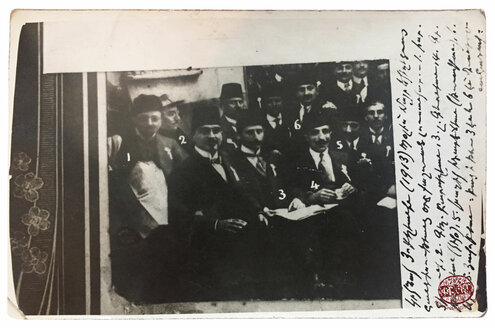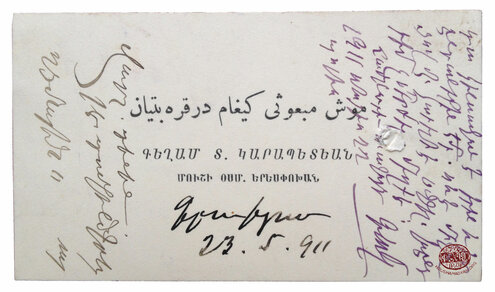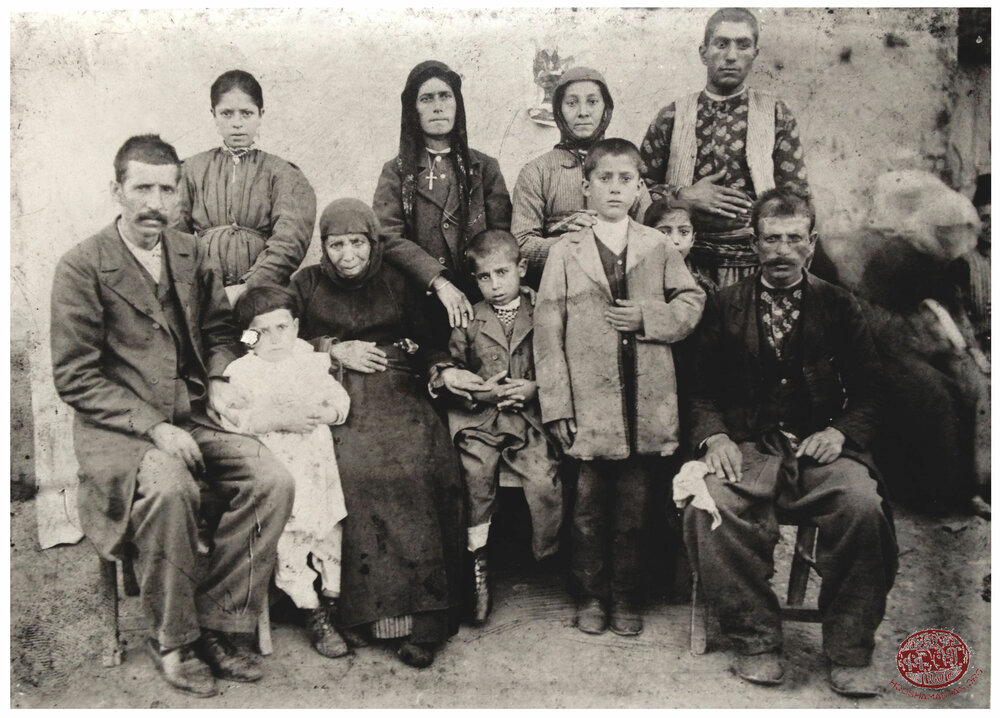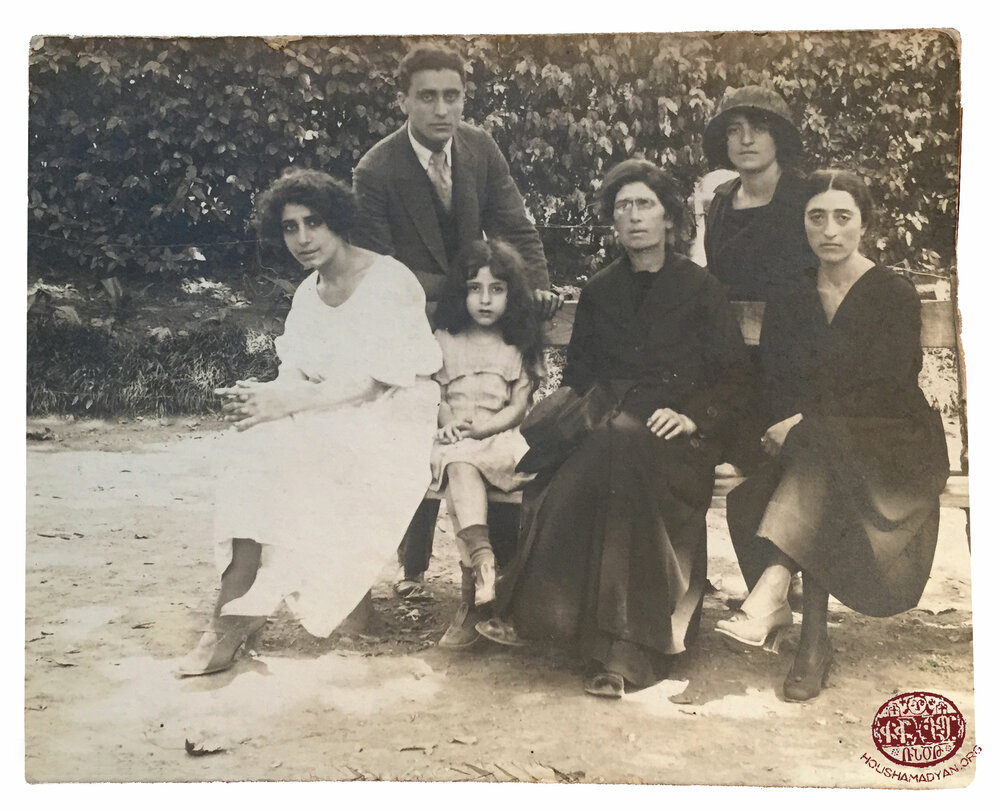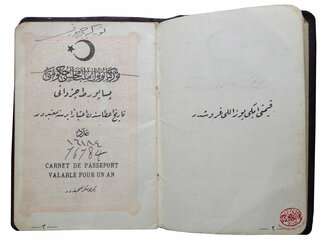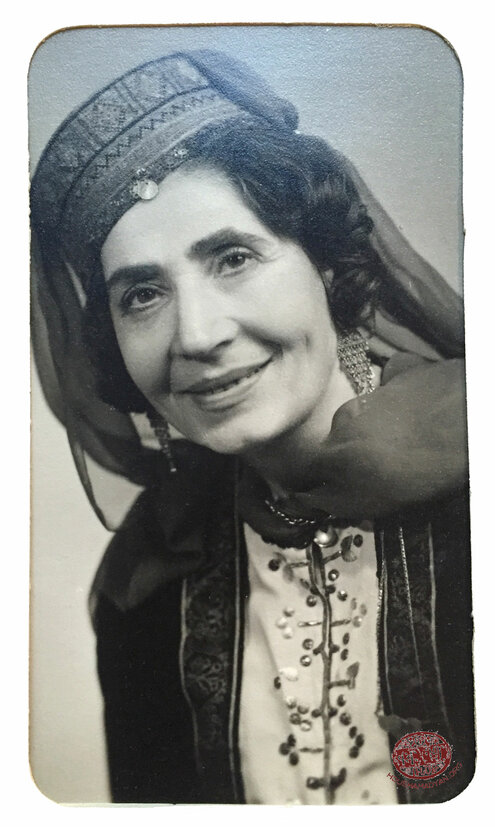Moush - Song: Armenouhi Kevonian
Author: Kegham Kevonian (Last modified: 17/03/2017) - Translator: Simon Beugekian
Im Anoush Msho Ashkharh (My Sweet Land of Moush) poem by Soghomon Darontsi recited by Armenouhi Kevonian

Armenouhi Kevonian was born in Moush, in the Saint Marine neighborhood, in 1902. She was the daughter of Kegham Der Garabedian (1856-1918), the writer, activist, and member of parliament from Moush; and the historic Gulizar (1875-1948). Kevonian’s childhood was spent in the City of Moush and the surrounding Moush Valley, where she was in constant contact with Armenian peasantry, and was imbued with their folk traditions, particularly the traditions related to pilgrimages to the local monasteries. She spent her childhood sharing the joy and grief of Moush Armenians.
In the autumn of 1914, Armenouhi and her mother made their way to Istanbul, via Kars and Sebastia. Miraculously, they survived the Armenian Genocide. Armenouhi would later graduate from the Esayan School in Istanbul, where she later served as a teacher. She also joined the staff of the school of the St. Krikor Lousavorich (St. Gregory the Illuminator) Church in Ghalatia. During these years, as a student of Krikor Suni, Armenouhi often performed, as a budding singer, in concerts for the local Armenians. She was also a singer in the newly formed choir of Komitas’ Five Disciples, alongside Koharig Ghazarosian and Ardashes Semerjian.
In 1925, as the head of group of Armenian Catholic immigrants, she relocated to France and established residence in Paris. There, she worked in the office of the Armenian Catholicosate, alongside Bishop Krikor Balakian. Later, she worked in the editorial offices of the Harach newspaper, while simultaneously apprenticing under vocalist Markarid Babayan and prominent pianist Dirouhi Zarapian. In later years, she was also a student of Jean Jambaz and Suzanne Hedwan, a singer at the Paris Opera.
In order to ascend and visit the Sourp Arakelots (Holy Apostles) Monastery in Moush, you need to go to the village of Haragh in eastern Moush and take the southern road to the monastery. When the French art historian Jean-Michel Thierry was visiting the region, the Haragh villagers drew a cross on the ground to show him their hidden identity. They gave him the cross they had in their possession hoping it would be saved. When Thierry returned to Paris, around 1975, he gifted the cross to Armenouhi Kevonian knowing that she had been to Sourp Arakelots as a child. It is currently part of the Kevonian family collection.
After more than 20 years of performing songs by Komitas, Vartan Sarkisian, Ara Bartevian, Krikor Mehrab and Avedis Mesouments, in 1948, Kevonian delivered a performance of traditional songs from Daron. The performance was sponsored by Arshag Chobanian. These songs were a novelty for the audiences, and after the success of the concert, the Daron-Dourouperan Compatriots Union invited Kevonian to the United States. From 1949 to 1951, from New York to San Fransisco, in ten American cities, she created a huge wave of excitement among Armenians, both with her catalogue of songs and her costumes. In 1953, Kevonian traveled to the Middle East, where she performed in three concerts in Beirut and Aleppo.
Approximately ten years later, in 1962, Kevonian once again appeared before the Parisian public. She performed in Paris three more times, in 1967, 1977, and 1979. During those same years, between 1963 and 1978, thanks to the generosity of the Armenian community in Paris, she was able to travel to Armenia five times, performing for music lovers and academics in Yerevan, as well as in the lyceum of Echmiadzin. Her performances were facilitated by the Union of Diaspora Armenians (or the committee for relations with Diasporan Armenians).
She also visited Istanbul (1969), Venice (1970), Lyon (1980), and Nice (1981).

1) Gulizar (1875-1948) is seated on the left with Armenouhi Der Garabedian (later Kevonian) standing next to her. This photograph was taken in Jerusalem.
2) Gulizar is seated in the middle, Armenouhi Der Garabedian (later Kevonian) is standing on the left. The girl standing on the right is Yeranig Der Garabedian (Zakar Der Garabedian's daughter, Zakar was one of Kegham Der Garabedian’s brothers, he died in 1907). This photograph was either taken in Moush or in Istanbul.

After the 1960s, Kevonian used taped playback during her performances. Thus, thanks to poet Mary Atmajian, and her husband Charles DeChevalier, almost all of the known songs of Daron were recorded onto tape. This collection was released as an album entitled Folk Songs of Daron and Other Regions.
Later in 1978, thanks to the efforts of musicologists Cecilia Proudian, the same collection of songs was released in Yerevan, recorded by Levon Asdvadzadourian.
Armenouhi Kevonian’s catalogue offers the public a collection of folk songs interpreted by a native of the very areas where these songs originated. Kevonian chose to interpret songs from the land of Daron – the City and Valley of Moush – and from the mountains of Sassoun, areas that had left a deep impression on her during her childhood years. Her inspiration came from her family, from Armenian peasantry, from the music she had heard during feasts and the holy sites she had known so well in her youth. Her work echoed the daily life of Armenian peasants, the joys and the pain of the daily life of her people, the depth of their piety, and the legendary battles of Armenian history.
Her songs always preserved their original musicality. Many of them had unique structures, and many others were divided into stanzas, which she shortened for the sake of brevity. She also made occasional additions, and in a few cases, added verses that were missing in the originals. Her catalogue includes love songs, dance songs, dirges, minstrel songs, and revolutionary songs. Due to circumstances, her performances were mostly recorded between 1961 and 1971, sometimes even later and therefore, in some cases, the music was copied from old, low-quality recordings, without musical accompaniment.
The goal of this Dvadzourig (God-given) singer was not only to rescue folk music from obscurity, but also to pass on this legacy to future generations in the most authentic form possible.
By allowing listeners to enjoy unique recordings that preserve the spirit and artistic style of Daron, Armenouhi Kevonian wishes to at least add one brick to the work of reconstructing a world that has been shattered into a pile of ashes.

Photo and music gallery
This photo and music gallery contains archives from the Der Garabedian and Kevonian archives, which Kegham Kevonian has graciously put at Houshamadyan's disposal. There are photographs from the family's time in Moush, later Istanbul and finally Paris, there are also archives tracing Armenouhi Kevonian's (born Der Garabedian) music career. Whereas the song gallery gives us the unique chance to listen to Armenouhi Kevonian's beautiful voice performing popular Armenian songs from the region of Daron, which were collected and interpreted by Armenouhi herself.

1) The book "Daroni Ashkharh, Badgerner ou Badmevadzkner" (The World of Daron, Images and Stories), book by Kegham Der Garabedian, published in Paris, France in 1931.
2) The first page of the book, the right page shows the Content page, the left page bears many signatures, there is Garo Sasouni's, Vazken Shoushanian's, Ohan Garo's, Mgerdich Yeritsants', Simon Vratsian's, Mgerdich Barsamian's and Levon Mozian's signatures among others.

1) Photograph taken in Istanbul in 1913, at the Mother Church. The handwritten explanation note on the photograph reads: for the occasion of the double jubilee. Could this have been the solemn celebration on the occasion of the invention of the Armenian alphabet? Here are the identified people: 1) Israel Dkhrouni, 2) Kegham Parseghian, 3) Levon Kevonian, 4) Krikor Torossian (Gigo), 5) Khatchig Idarejian and 6) Armen Hagopian. All fell victim to the Genocide, except Levon Kevonian and Armen Hagopian, who survived.
2) Kegham Der Garabedian's business card as an Ottoman parliamentary representative from Moush. The card is in two languages, Armenian and Ottoman Turkish. It's most probably from 1911.
From left to right: Nartoun (Gulizar’s step mother), Der Haroutyoun (Gulizar’s paternal uncle), Gulizar (who was from the village of Khars), the identity of the child sitting on the floor is unknown. This photograph was taken in Istanbul during Gulizar’s trial, around 1889.
When she was a teenager, Gulizar had caught the eye of a Kurdish chief, Mousa Beg, who after being rejected, decided to abduct her. He kidnapped the 14 year old Gulizar and took her to his village Hedevig. Gulizar did not have the same fate as many of the girls who were kidnapped like her, mainly because of her story of resistance. Besides her force and resistance, it is thanks to the efforts of her family that Gulizar appeared in different courts, to prove her identity; the most famous of these court appearances was the one in Istanbul, which was covered by the international press. As such, Gulizar returned to her family and later married Kegham Der Garabedian.

This photograph was taken in Moush in 1905. Sitting from left to right are: Kegham Der Garabedian, Nartoun (Gulizar’s stepmother) and Aram Der Garabedian (Gulizar and Kegham’s son). The small child standing next to Kegham Der Garabedian, wearing white, is Armenouhi Der Garabedian (later Kevonian). Standing from left to right are: Hayganoush Der Garabedian (Armenouhi’s sister, Gulizar and Kegham Der Garabedian’s eldest daughter, who passed away before the Genocide, when she was about 15 years old) and Gulizar (wearing a big cross around her neck).

1) This famous photograph of Gulizar was taken in Istanbul during her trial, around 1889.
2) Aram Der Garabedian, Armenouhi Der Garabedian’s (later Kevonian) brother – Gulizar and Kegham Der Garabedian’s son.
3) Standing from left to right are: Torkom Der Garabedian (he is Kegham Der Garabedian’s brother’s, Yeghishe Der Garabedian, son) and Torkom’s wife. The lady sitting in the center is Zmroukhd (Torkom’s mother), the two young children are Torkom’s children. This photograph was most probably taken in Moush. In the aftermath of the Genocide, a part of Torkom’s family was islamized and continued to live in Diyarbakir/ Dikranagerd.
4) Gulizar is sitting on the right, her son Aram Der Garabedian is sitting on the left. Torkom Der Garabedian, wearing his army uniform, is standing behind them in the center of the photograph. He is Kegham Der Garabedian’s brother, Yeghishe Der Garabedian’s son. Some part of Torkom’s family were islamized and lived in Diyabakir/ Dikranagerd. This photograph was taken in Istanbul, around 1929.

Group photograph of Armenians, location unknown, the photograph must have been taken in the Ottoman Empire between 1909 and 1914. Five of the men in the photograph are wearing the Ottoman army’s uniform, it’s clear that they are recently enlisted Armenians. According to the notes on the backside of the photograph, the people are identified as follows (the explanations following the names show the individuals' fate/current location).
Vosgian Chaderjian, left for the United States 2) Vahan Mazmanian, military doctor, was murdered at the hands of the the Mustafa Kemal army in Cilicia 3) Vartan Telalian, officer of the army, commander, died in Yerevan 4) Vartan Paroungaian (?), veterinarian 5) Haroutyoun Barsamian, 6) Haygazoun Delighazarian, America, editor of the newspaper “Hayrenik”, now Ghazarian 7) Hovsep Zrigian, agronomist, killed during the war (most probably during the first world war) 8) Hagop Der Kevorkian, officer 9) Arshag Bahjejian, a friend 10) Nerses Der Krikorian, officer, America 11) Armenag Ajemian, lawyer, (…) killed 12) Dikran Kouyoumjian, sylviculturist 13) Veroum Yetimian, he was islamized in Istanbul for no reason, currently lives in Sivas/Sepasdia and is married to a Turkish woman.

The Pteyan family (from Moush). Seated in the center is Misak Pteyan (1868-1958), sitting on the far right is Sarkis Pteyan (1867-1930). Sitting on the left is Pekso (?). Sitting on the floor from left to right are: Alice and Zareh. Standing from left to right are: Aghavni, Anahid, identity unknown, Ashkhen, Hratch and Armenouhi. It is worth mentioning that the brothers Sarkis and Misak Pteyan are the authors of the book “Genuine History of Daron” (in Armenian) which was published in Cairo in 1962.

Istanbul, after the war, probably in the Taksim garden. Seated from left to right are: Armenouhi Der Garabedian (later Kevonian), the adopted daughter of the Markarian family who had survived the Genocide, Gulizar and Vehanoush Markarian (Arpiar’s sister). Standing from left to right are: Arpiar Markarian and Eliz Markarian (Arpiar’s other sister).


Songs from Daron and Other Popular Songs, collected, arranged and performed by Armenouhi Kevonian. Front and backside of the vinyl record. The front side shows a photo of the Sourp Arakelots (Holy Apostles) Monastery (Tarkmantchats Monastery) photographed in 1904. The backside of the vinyl has Armenouhi Kevonian’s biography, which is published in this page, and also has the list of songs you can listen to on this page dedicated to the songs of Moush…
Song titles:
SIDE A
0) Reciting the poem about Moush by Soghomon Darontsi (1904-1971, born in the village of Gop (Bulanık) in Daron, he was a poet, prose-writer and translator) 1) Habrban 2) Shousho 3) Yarimo (My Beloved) 4) Imal Enk 5) Dzkhakhodi Yerk (The Cigarette Song) 6) Yeghso Jan, Shmavon Jan (Dear Yeghso, Dear Shmavon) 7) Hampartsman Yergoushaptin (The Ascension Monday) 8) Vi, Vi, Vi, Vi! 9) Voghp Kheghtvadz Yaroch (Lament for the Beloved who Drowned) 10) Veran Ashoun
11) Alashgertsik Partsan Katsin (The Alashgertsi’s Left) 12) Voghp Arevankevadz Aghchega Mor (Lament for the Mother of the Abducted Girl) 13) Arakel Moushegh 14) Nado 15) Kevork Chaoushi Yerk (The Song of Kevork Chaoush) 16) Zinvori Yerk (The Soldier’s Song).
SIDE B
17) Dloy! Loy! 18) Ge Nmani (Resembles) 19) Me Keli Pobig Khorodig (Don’t Walk Barefoot Beautiful!) 20) Paghemi Jan 21) Kya Sev Sevavor Aghchig (Dark Dark Girl) 22) Babig Mamig Garkek Zis (Mom Dad Marry me off) 23) Kisherva Zanker Zargetsin (The Night Bells Rang) 24) Eni Vorn Er Ichav Saren? (Who Came down from the Mountains?) 25) Changle Zim Mourade Dour 26) Sourp Garabed (St. Garabed) 27) Delilim, Yernig Nannig, Ninnaye 28) Yelnim Sarer (I’ll Climb the Mountains…) 29) Baron Inch Ge Bddis? (Sir, Why are you Promenading?).

Paris in the 1930’s, celebrating May 28th (?).
To the right of the photograph, the little girl wearing a gingham dress, right behind the band members, is Anahide Kevonian (later Ter Minassian, she is Armenouhi and Levon Kevonians’ daughter). Right behind Anahide is Simon Vratsian, to his right is Levon Kevonian, while to his left is Kerasim Paladian and then Armenouhi Kevonian. To the left of the photograph, the first row after the musicians: to the far right is Arshag Chobanian (while clapping), the third person in the same row as Chobanian (wearing glasses) is Shavarsh Misakian. Three rows behind Arshag Chobanian, the person wearing glasses is Hrant Samuel.
Photograph taken in Paris. First row, sitting on the floor, 4th from the left is Vazken Shoushanian. The middle row, sitting 5th from the left is Tateos Madzadourian, the 7th is Gyulkhantanian. Back row, standing, 3rd from the left is Mgerditch Yeritsants, the 4th is Levon Chormissian and the 5th is Levon Kevonian.

Paris, 1920's. Tashnag party members at an event.
Sitting from left to right are: Avetis Aharonian is third, Simon Vratzian is fourth and Roupen Der Minassian is sixth.
Second row, standing form left to right are: Shavarsh Missakian is first, Shahan Natalie (wearing a striped tie and glasses) is sixth and Arshag Chamalian is eight.
Third row, standing from left to right are: Hrant Samuel is sixth, to the far right.

1) Article published in Armenian on the occasion of Armenouhi Kevonian's (born Der Garabedian) death, it also refers to her early life, biography, musical career and concert tours.
2) Armenouhi Kevonain photographed in the attire she would often wear to her concerts. The hat "arakhchi" which she wears is from Moush and traditionally the arakhchi is a man's hat. The arakhchi is currently part of the Kevonian family collection in Paris.

Kegham Kevonian’s lecture
Here you can listen to the Kegham Kevonian’s lecture about Armenouhi Kevonian. The talk, in French, was given on the Péniche Anako (the Anako Barge) in Paris and is about two hours, during which Kevonian presents the world of Moush, talks about Armenouhi’s family history and about the singer’s career. The lecture is accompanied by songs from Armenouhi’s repertoire which are performed by Virginia Kerovpyan, you can also hear recordings of Armenouhi’s performances...











